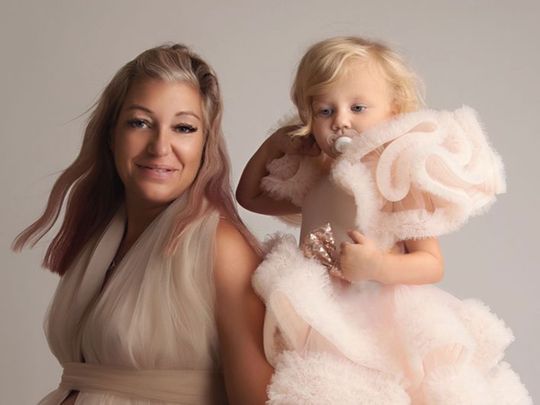38-year-old Briton in UAE: ‘C-section trauma is real’
She didn’t know where the wisps of happiness ended and the abject terror began – what she did know was that she had been wrapped in a blanket of this make for 39 weeks.
Gemma Ovens, a British expat in the United Arab Emirates, was pregnant. The initial joy of learning she was pregnant remained, but the memories of previous losses – she had had two miscarriages before that – splashed through her from time to time like icy water.
Ovens remembers searching Google for hours, scaring himself with lists of “what could go wrong.” “When I was pregnant with Pearl, it was a very anxious pregnancy. Every day was anxious.
“They kind of called it a precious pregnancy. They didn’t really want me to leave in over 40 weeks or get too heavy. I was extremely anxious towards the end and just wanted her in my arms. And then they kind of decided that if there was no sign of engagement from Pearl within 40 weeks, they wanted to borrow the C section. Thirty-nine weeks and four days later, I had a caesarean section. Looking back, I wish I had more support with the anxiety and with, you know, the options that were there. But I was quite vulnerable at the time,” the 36-year-old recalled.
High risk pregnancies
“Pregnancy at both ends of the spectrum, i.e. early pregnancy and older pregnancy, requires more vigilant prenatal monitoring compared to the normal expected range of childbearing age. When we talk about age advanced maternal, we are referring to pregnancy occurring after age 35,” says Dr. Mahnaz Fazal, specialist in obstetrics and gynecology, Medcare Medical Center.
But as a first-time mom, she pulled through. She regrets not receiving emotional – and practical – support. “I wish I had someone to mentally help me understand that my pregnancy was progressing very well, that the miscarriages happened for a reason, and that a natural birth would eventually have happened.” (Globally, an estimated 23 million miscarriages occur each year, reports the international journal “The Lancet” in the article “Miscarriage: Global Care Reform Needed.”)
The big operation
“I think if you’re a first-time mom, sometimes you get carried away, or you can be a little clueless and vulnerable. And you just follow what you think is right at the time,” she says.
Gemma Ovens with her baby Pearl.
Image Credit: Supplied
When Ovens gave birth, she was lying on an operating table and had just enough time to see Pearl before she was taken away. There was no skin-to-skin contact – and Ovens couldn’t get up to see his child; he had been asked to lie still for about 12 hours. “I haven’t seen her for a few hours. And then when the nurse came back, I asked her to lie down with me. And she did. So we had a few hours then,” she says.
But she couldn’t feed her, couldn’t change her – she was a new mom, no doubt, but she couldn’t do the things that would have helped her hormones stabilize. She just watched from her bed, propped up on pillows and wanting to move on. “The pain when you try to get up and start walking again [is terrible], she shivers.
“Nobody tells you that the rehabilitation from the C-section is going to be so severe,” she says. “Especially if you exercise and want to get back into exercising; I was a little naive about the amount of rehab needed to get back to this point. You know, it’s not a small operation that you can recover from,” she said.
Fours had also gained weight during this pregnancy – from 69kg to 96kg. Fifteen days after giving birth, she was still 16 kg overweight. As a physical education teacher and someone who had always been active, stagnation was foreign. “The whole trip for me was quite frustrating. And it took me a long time to rehabilitate myself so that I could get back to where I was before the pregnancy,” she says. What this trip has done for her to give her some perspective; a trained prenatal and postnatal fitness instructor, she says she didn’t realize how difficult recovery after a postpartum C-section was.
Back to basics
“I didn’t do anything for about, I would say four weeks, then I started very, very short walks. I was just trying to walk a little bit further each time, then I started with some stretching because I found my body was very tense, very stiff; my posture was bad, due to pregnancy and walking after the caesarean,” she explains. Slowly, about eight weeks later, she began to include other exercises such as weightlifting and other bodyweight movements.
Exercise and breast milk
As long as you eat enough calories and stay hydrated, there is no impact on breast milk. Breast milk will only go bad if you don’t eat enough, aren’t hydrated, and overdo it during exercise. So there has to be a balance, says Gemma Ovens. A recent study, “Maternal Exercise and Growth in Breastfed Infants: A Meta-analysis of Randomized Controlled Trials” published in the international journal Pediatrics, suggests that mothers can exercise and breastfeed without affecting their baby’s growth.
“What I struggled with was that I hadn’t realized how much trauma had come from having a c-section. I struggled to look at the scar,” she says. “Had some emotional healing to do in regards to the scar. I was upset, especially because on top of everything, I also had diastasis recti the first time around,”
What is diastasis recti?
The US-based May Clinic website explains, “During pregnancy, the growing uterus stretches the muscles in the abdomen. This can cause the two large parallel bands of muscle that meet in the middle of the abdomen (rectus muscles) to separate abnormally – a condition called diastasis recti or diastasis recti abdominis. Diastasis recti can cause a bulge in the middle of the abdomen where the two muscles separate. Gemma Ovens says it takes specific breathing exercises to resynchronize the core and strengthen the muscles to bring the two muscles together. Over time, using exercise and posture correction tools, she says, she healed herself. Now, Ovens is working with other moms to help them with the condition.
Two years later, Ovens is pregnant again. This time, she refuses to enter unknowingly. She has taken hypnotherapy courses, which she heartily recommends. She has a birth plan. “I’ve tried to do a lot of mental work in case it comes back on track for the caesarean section, because I’m absolutely petrified to have the operation and to have to heal again.”
What is hypnobirthing?
Hypnobirthing teaches expectant mothers a practical way of self-hypnosis, relaxation, and other calming techniques while educating her about the birth process to make the process easier.
“All hypnobirthing classes generally follow the same holistic approach to pregnancy and labor. Essentially, we provide all possible information to parents so that they feel empowered and secure enough in their knowledge and abilities to be able to take control over their pregnancy and labor and have a birth experience they want and deserve, whatever shape or form that may take,” says Tessa Kiernander, UK-based clinical hypnotherapist at Mind Solutions.
She also exercised – weights and all! “So the rule of thumb is if you’ve always exercised – I’ve always lifted weights and always exercised – you can keep going. And for the first three months, you you can just carry on with what you were doing until the doctor says the rest for whatever reason.What is not advised is if you have never really exercised , but you get pregnant and you want to start a new routine, you can’t start lifting weights, it has to be, you know, walking or swimming, under the guidance of a trained person, and after you get the I got the go from the doctor as well. So I always did squats and deadlifts and did whatever I was doing. Obviously the weights went down as the pregnancy progressed.
A relaxed second pregnancy
Oven says this pregnancy has been so much more relaxed than the previous one. “I’ve been so busy with my daughter, with the business; it was much more relaxed, which was great. We won’t have any more kids after this one, so I really wanted to kiss her. I haven’t gained that much weight. I probably worked harder during this pregnancy because I was a little more relaxed. So I kept up the weight training. Whereas with Pearl I was losing weight and doing more circuit and cardio based exercises. So yes, it was much better in that regard, I enjoyed it more.

Gemma pregnancy session
Image Credit: Supplied
Research – and relaxation – are key to unraveling the veil of emotions that envelops expectant mothers so that the terror is gone and the joy remains. You can have a happy pregnancy.
Tell us about your pregnancy journey at [email protected]


Comments are closed.